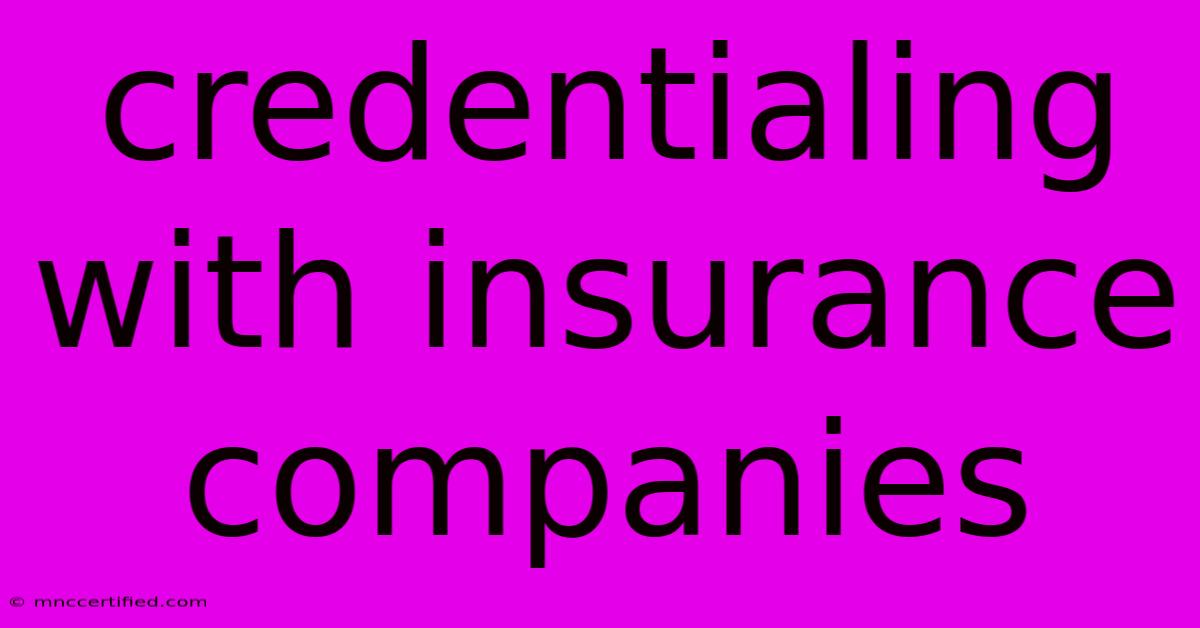Credentialing With Insurance Companies

Table of Contents
Unlocking Access: A Guide to Credentialing with Insurance Companies
For healthcare providers, navigating the complex world of insurance credentialing is essential for success. This process, often described as "getting in-network," ensures you can bill insurance companies directly for services rendered, allowing patients to utilize their benefits and you to receive timely payments.
This comprehensive guide will delve into the intricacies of insurance credentialing, providing actionable steps and insights to streamline the process and ensure smooth reimbursements.
Understanding the Basics: What is Credentialing?
Credentialing is the process by which healthcare providers demonstrate their qualifications and expertise to insurance companies. It involves submitting documentation, including licenses, certifications, and other credentials, to prove your eligibility to provide care and receive payment. This process allows insurance companies to verify:
- Provider qualifications: Are you licensed and certified to practice in your state?
- Professional experience: Do you have the necessary expertise to provide the services you offer?
- Provider network: Do you meet the insurance company's specific criteria for inclusion in their provider network?
The Importance of Credentialing: Why It Matters
Credentialing is crucial for any healthcare provider looking to:
- Maximize revenue: Accepting insurance allows you to tap into a larger pool of patients, increasing your revenue potential.
- Streamline billing: Billing insurance directly simplifies the payment process for both you and your patients.
- Build patient trust: Being in-network with major insurance companies signals credibility and makes it easier for patients to choose your practice.
The Credentialing Process: Step-by-Step Guide
The credentialing process varies depending on the insurance company, but generally involves these key steps:
- Application submission: Begin by completing an application form for each insurance company you wish to credential with.
- Documentation gathering: Collect all necessary documents, including your medical license, DEA number, malpractice insurance, and other required certifications.
- Credentialing review: The insurance company will review your application and supporting documentation to verify your qualifications.
- Provider enrollment: Once your credentials are verified, you will be enrolled in the insurance company's provider network.
- Ongoing maintenance: Keep your credentials up-to-date by notifying the insurance company of any changes to your practice, license, or certifications.
Key Considerations: Tips for a Smooth Credentialing Experience
- Start early: The credentialing process can be lengthy, so it's best to begin well before you plan to accept insurance.
- Stay organized: Maintain a comprehensive file for each insurance company, keeping all documentation in order.
- Utilize credentialing software: Dedicated software can help streamline the application process, track deadlines, and manage communication.
- Be proactive: Follow up regularly with the insurance company to ensure the process is moving forward and address any outstanding questions or requirements.
- Seek professional assistance: Consider working with a credentialing expert or outsourcing the process to a credentialing service to help navigate the complexities of the process.
Off-Page SEO Strategies for Success
- Local citations: Create consistent listings on relevant directories like Yelp, Google My Business, and Healthgrades.
- Social media: Actively engage with your audience and share valuable content related to your services.
- Industry associations: Join professional organizations and participate in industry events to build connections and enhance your online presence.
- Online reviews: Encourage satisfied patients to leave positive reviews on reputable websites.
Remember: Credentialing is an ongoing process, requiring vigilance and commitment. By understanding the process, staying organized, and leveraging available resources, you can successfully navigate the world of insurance credentialing and maximize your practice's success.

Thank you for visiting our website wich cover about Credentialing With Insurance Companies. We hope the information provided has been useful to you. Feel free to contact us if you have any questions or need further assistance. See you next time and dont miss to bookmark.
Featured Posts
-
Community Saves Zoes Place Hospice
Nov 09, 2024
-
Grammy Awards 2025 Nominee List Revealed
Nov 09, 2024
-
76ers Vs Lakers Prediction Odds And Picks
Nov 09, 2024
-
Live Ireland Vs New Zealand Autumn Nations Series
Nov 09, 2024
-
Medical Director Malpractice Insurance
Nov 09, 2024